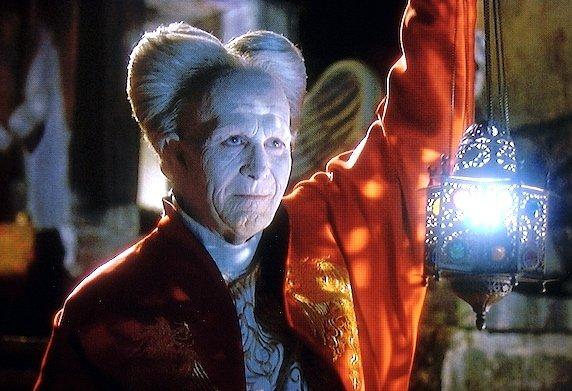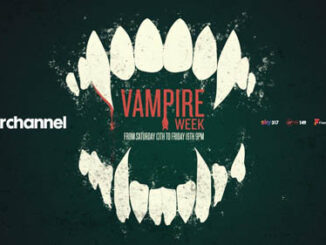
When writing Dracula, I bet Bram Stoker could never have imagined how much the public would embrace the idea of vampires as part of supernatural fiction.
Hundreds of films have been made about the centuries-old bloodsuckers that sleep throughout the day and hunt for prey at night.
In this article, we’ll take a look at some of the very best vampire movies you simply have to see!
SALEM’S LOT
Novelist Ben Mears (David Soul) returns to the small town of Jerusalem’s Lot, Maine to discover all is not what it seems. With increasingly odd things going on, he suspects the Marsten house overlooking the town contains many of the answers along with its mysterious owner Mr Barlow.
Salem’s Lot is one of those cracking films adapted from a Stephen King novel and is different to most vampire movies in that the main culprit isn’t to be seen for most of the film, though the consequences of his actions certainly are.
A certain scene with Ralphie Glick at the bedroom window has terrified many and even made it into our scariest scenes list.
NEAR DARK
A young man falls for a woman who he discovers is a vampire and reluctantly joins her group of travelling bloodsuckers who cause chaos wherever they go.
Kathryn Bigelow’s more humane take on vampires and the struggles in which they live is every bit captivating as it is enjoyable. Starring Adrian Pasdar as farm boy, Caleb, and the brilliant Bill Paxton and Lance Henriksen as members of the wicked family of vampires, Near Dark is full of bad-ass charm wrapped up in a road movie.
BRAM STOKER’S DRACULA
As the title suggests, Bram Stoker’s Dracula follows the novel very closely. Young lawyer Jonathan Harker travels to Transylvania to meet with Count Dracula to finalise the details on a property acquired by the nobleman in England. The Count imprisons the young man in his castle and departs for England to woo Joanthan’s fiance, Mina Murray, who he believes is the reincarnation of his lost love, Elisabeta.
Bram Stoker’s Dracula, directed by the great Francis Ford Coppola, is one of the best vampire movies ever made! With the terrific Gary Oldman as Dracula, he’s both dashing and enigmatic as he strolls around town as his ‘younger’ self, and positively frightening as his real older self.
This 1992 film has been spoofed many a time, most notably by The Simpsons in which Mr Burn’s adopts the same hairdo as Oldman’s Dracula.
Bram Stoker’s Dracula has a cast to die for (Winona Ryder, Anthony Hopkins, Richard E. Grant, Cary Elwes, Sadie Frost, Tom Waits) and even features Monica Bellucci in the role as one of Dracula’s vamp women who seduces Keanu Reeves’ Jonathan Harker in one of the Count’s bedrooms. Reeves’ English accent has been the source of ridicule for many years but adds to the film’s charm. A classic.
FROM DUSK TILL DAWN
Criminal brothers Seth Gecko (George Clooney) and psychotic Richie Gecko (Quentin Tarantino) are on the run from the law when they kidnap a family of three, headed by former minister, Jacob (Harvey Keitel). Dragging their hostages to a roadside bar named Titty Twister across the Mexican border, Seth promises to release the family after his rendezvous with Carlos, who’s meeting him at the bar the next morning, but will they survive the night?
A comedy-action take on the vampire genre, Robert Rodriguez’s From Dusk Till Dawn is very much a murderous drama for the good first half of the film before turning into something much more supernatural in the latter half. How can you dislike a film where Danny Trejo, Cheech Marin and Salma Hayek are vampires doing battle with George Clooney, Quentin Tarantino, Juliette Lewis and Harvey Keitel?
INTERVIEW WITH THE VAMPIRE
A journalist (Christian Slater) interviews vampire Louis (Brad Pitt) on his life, from being turned to living out his immortal existence with vampire Lestat’s companion.
Based on Anne Rice’s novel of the same name and directed by Neil Jordan, Interview With The Vampire is probably the most mainstream of these vampire movies, featuring the acting chops of Brad Pitt, Tom Cruise, Kirsten Dunst and Antonio Banderas.
In the film, we follow Louis’ journey of becoming a vampire in the 18th century and discover that it’s not all what it’s cracked up to be. Not even the introduction of a vampire child, Claudia, into his relationship with Lestat can lessen the pain and torment he suffers though he takes to becoming a guardian for the young girl. Whilst Lestat enjoys the thrill of being immortal and preying upon humans, Louis despises the idea and continues to struggle to accept the fate he chose.
Whilst Brad Pitt’s Louis is the whiny of the bunch, Tom Cruise’s Lestat is definitely the fun-loving highlight. Scary and powerful, his moments light up the screen. The tension really comes to the forefront with the introduction of Claudia, especially when she’s spent decades with the two of them and becomes frustrated that she’s a psychologically adult woman trapped in an eternally young body.
Interview with the Vampire is one of those fascinating vampire movies to analyse because of the different experiences the various vampires go through. Some take to life as a vampire more easily whilst others have regrets. Some don’t even have a choice.in the matter.
Though it feels quite the blockbuster in many ways, this is not your ordinary vampire movie.
THE HUNGER
An ancient vampire named Miriam (Catherine Deneuve) has been living with her current partner John (David Bowie) for over 200 years. When John begins to suffer from insomnia and appears to age drastically in just a matter of days, he decides to seek help from Dr Sarah Roberts (Susan Sarandon). Whilst at first she fears he’s overreacting, she quickly realises that John is in desperate need of her help.
This seductive, sensual flick, featuring a love triangle between the three main characters, is one of the finest vampire movies ever made and gained a cult following for good reason.
Loosely based on Whitley Streiber’s 1981 book of the same name, The Hunger is a quiet powerhouse of a vampire movie thanks to the performances of its three leads and its captivating plot of a vampire who’s simultaneously afraid of being alone yet treats her partners like used tissues.
Featuring music from goth band Bauhaus and a striking placement of classical piece, Lakme (The Flower Duet), The Hunger is an iconic vampire movie of the 1980’s.
WHAT WE DO IN THE SHADOWS
Shot as a faux documentary, What We Do In The Shadows follows the lives of three ancient vampires Viago, Vladislav and Deacon (and Petyr) as they try to fit in with modern society in Wellington, New Zealand.
This horror comedy from New Zealand had the audience roaring their head off with laughter at Grimmfest and for good reason. Written and directed by Jemaine Clement (Flight of the Conchords) and Taika Waititi, who also star in the film alongside Jonathan Brugh, the film brilliantly pits the classic horror tropes of vampirism against the technological and societal headaches of modern life, resulting in a laugh-out-loud spectacle.
Gore is firmly pushed to one side as this vampire movie is aimed at sinking its teeth into the comedy jugular instead and is cleverly put together to delight fans of the genre.
Such was the success of the movie upon its release in 2014, What We Do In The Shadows went on to spawn a television series.
DRACULA: PRINCE OF DARKNESS
Despite warnings from the locals, two couples on holiday in Transylvania find themselves stranded near Castle Dracula. The place’s owner has been dead for ten years but his butler Klove is alive and kicking [just about] and these guests might be just what he needs to carry out his plan of reviving his master.
Most top vampire movie lists have Hammer’s 1958 Dracula as the iconic company’s greatest achievement and certainly their greatest vampire flick, but there’s a strong case for this sequel being the better film. With the studio style flowing in full force, director Terence Fisher creates a stunning piece of Gothic horror, oozing with atmosphere in its first half until the Count is up and about, after which the thrills come at a non-stop pace.
Christopher Lee remains the definitive Dracula to many, and here his presence is continually felt despite little screen time and no dialogue [he just hisses]. Andrew Kier’s Father Sandor is so formidable an adversary that we wish he’d returned for further adventures. And let’s not forget Barbara Shelley’s stunning [despite accidentally swallowing her fangs at one point] turn as Helen, the uptight, nervous lady who becomes a sexual creature of the night. Her death scene is a quite excruciating highlight in a film which pushed the violence and gore just a little bit more.
Despite the absence of Peter Cushing, Dracula Prince of Darkness might just be the quintessential Hammer film.
VAMPYR
Drifter Allan Gray is obsessed with the supernatural. His stay at the French village of Courtempiere has him lured to a mill populated by shadows and ran by a creepy doctor and elderly lady, then to a house where the daughter of the manor, Leone, is slowly becoming a vampire.
Possibly the most glaring omission from this article is Bela Lugosi, who was even buried in his Dracula costume. Sadly none of his films quite make the best of the best in our opinion, but for an example of the unique spell that a vintage black and white horror film can cast, there are few better examples in the vampire category than the French/ German classic Vampyr.
Director Carl Dreyer turns a very simple story into a nearly endless parade of eerie imagery, shooting through gauze so that the resulting shimmer and softness creates a beautiful effect, while disjointed editing actually adds to the proceedings which uniquely take place in a world where light, more than darkness, is associated with fear. And talking of fear, this film contains a premature burial sequence which, even now, has the power to create chills.
Poetic and almost surreal in places, Vampyr heavily influenced the work of Jean Rollin, who several decades later made a series of offbeat, quirky vampire movies which have their own idiosyncratic pleasures.
MARTIN
Teenager Martin believes he’s an 84 year old vampire who’s welcomed by his willing victims. In fact he drugs then rapes his victims, though he does drink their blood. He goes to stay with his Uncle Cuda in Pittsburgh who wants to destroy him. Can Martin control his urges?
George A. Romero will forever be associated with the living dead, but he also tackled vampirism in this very psychological piece which might be both his most personal work and his most thought provoking. This is a vampire movie which asks us to decide whether its vampire really is one. He’s not afraid of the sun and has no fangs, except for when he dresses up to scare his uncle crying “there is no magic”! Yet he’s certainly addicted to the red stuff.
Devices like first-person narrative and black and white shots make this possibly Romero’s most stylised work. He populates it with richly drawn characters, and continually plays with cliche as he examines a variety of themes including religion, loneliness and perception with typical Romero intelligence while keeping some of that Romero humour, Then there’s the strange, passive performance of John Amplas which manages to be highly effecting in context. This means that, despite some of his actions, we desperately want his character to restrain himself and find companionship.
Martin does contain a few scenes of horror, but it’s its cleverness and its bleakness that really stay with you.
MR. VAMPIRE
Master Kau, a Taoist priest and expert in the supernatural, is asked to remove a body from the grave so that prosperity will come to the family. However, it hasn’t decomposed, so Kau moves it to his house for study, only for his foolish students Man-choi and Chau-sang to bring it back to life.
A simple synopsis of the first act can’t do justice to Mr. Vampire, a totally bonkers but absolutely infectious melding of slapstick, comedy of errors, martial arts and Chinese superstition. Chinese vampires hop rather than walk and are also blind, yet still manage to create a few truly tense moments among all the madness, and then there’s the lady ghost who threatens to kill one of our heroes with “sexual exhaustion”.
There’s lots of interesting new vampire law [for example sticky rice repels these vampires but god forbid you mistakenly use another kind], while the comedy is so varied that you’re bound to laugh a few times even if your serious side doesn’t initially take to all this goofiness, and there’s a strong centre in the form of Lam Ching-yin as Kau, the role that made him a star.
Mr Vampire is a perfect a representation of the golden age of Hong Kong cinema, an outrageously inventive, unpredictable and exciting 90 minutes that you’ll probably want to tell everybody else about as soon as you’ve watched it.
30 DAYS OF NIGHT
Based on the graphic novel of the same name, 30 DAYS OF NIGHT sees a community in Alaska facing a vampire attack during the titular period – a month in which they annually face darkness 24 hours a day without the sun coming up. The perfect setting for a vampire movie if there ever was one!
With the vampires, led by a chilling Danny Huston, tearing the townsfolk apart, the remaining residents must hide or fight for survival. With no-real way to reach outside communities, they’re stuck to fend off the blood-sucking beasties until the month has ended and light returns to their town once more.
Also starring Josh Hartnett and Melissa George, 30 DAYS OF NIGHT is one of the best vampire movies out there, especially due to the lengths they’ve gone to create an us versus them mentality, with the vampires having their own language in which they communicate, ramping up the fear factor as you just don’t know what they’re planning to do.
A chilling, brutal modern horror classic!
LET THE RIGHT ONE IN
With residents found murdered in the community and being constantly harassed by bullies at school, twelve year old Oskar finds life getting a bit too intense for his liking. He finds a glimmer of hope in a girl named Eli who’s recently moved into the same apartment building as him. Oskar grows close to Eli, a girl he counts as one of, if not his only friend but Eli isn’t all what she appears to be… but is exactly what he needs.
This coming-of-age vampire movie from Sweden struck a chord with many horror fans thanks to its predominant use of its young stars to tell its story. It’s about two young people finding each other at the right time. Oskar is becoming downtrodden by Conny and his friends who constantly humiliate, bully and hit him. All he wants to do is have the courage to fight back. Eli gives him that courage and acts as his protector, but Oskar also gives her something she’s rarely felt: a companion – someone who understands what it’s like to be alone and a cast out. Eli’s life is becoming a desperate struggle due to her tired father/guardian’s sloppiness leaving her to hunt for herself, but this only draws ever-increasing attention which threatens her very life.
Remade two years later by director Matt Reeves in what was a near scene-for-scene remake as Let Me In, Let The Right One In isn’t about scaring its audience but about a relationship between two lonely kids finding hope in each other, in a world that has tormented and turned its back on them.
Seen them all? Well, take a look at our full range of vampire movie reviews for more recommendations.





Yes, I know how great the others are (let the right one in especially) but there can be only one. Near Dark